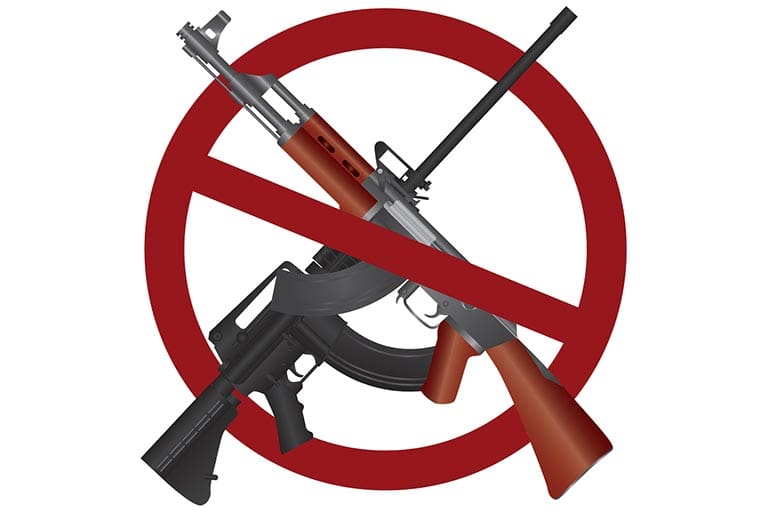By Tiger McKee [via tacticalwire.com]
Becoming efficient and effective with any tool relies on consistency; performing everything the same way, using proper technique regardless of the circumstances. This is especially true for defensive skills, when success or failure depends on your ability to perform under stress. Applying the Four Safety Rules consistently allows you to operate firearms safely. Let your mind wander for a fraction of a second, forget you’re holding a lethal weapon, and you make a mistake. Mistakes with firearms are embarrassing at best, but tend to be on the ugly side . . .
Not only do you have to focus on what you’re doing, you also have to pay attention to those around you. How many times has a friend offered to show you their newest pistol? Usually they’re asking the question while pulling it. The pistol flies out of the holster, their finger is probably on the trigger, and the muzzle is whipping about. Whenever someone starts with “Let me show you my new …” I immediately say “No thanks,” stepping to their side where I can control their hand and arm if necessary. Then I’ll follow up with the “some time later” explanation. Consistency is essential for safety.
Manipulating your weapon properly requires consistency. For every task you perform there are specific steps necessary to execute that action safely and properly. Look at loading, unloading or confirming the status of the weapon. This process, which should become a ritual, always begins with the magazine. You’re either inserting and locking it in, for loading, removing it from the weapon for unloading, or checking to confirm whether there is or isn’t a mag in the weapon. You cycle the action to load a round, unload, or confirm it’s unloaded. The sequence always ends by checking the chamber. Is it loaded or clear?
Now, imagine what happens when you deviate from this sequence, say while unloading. You cycle the slide, and see a round ejected. You remove the magazine and forget to check the chamber. Then, you begin treating it like an “unloaded” weapon, disregarding Rule I. Since the sequence was performed out of order all you did was eject one round, chamber another, and then removed the magazine. There’s still a round in the chamber. Consistency. Got it?
What about reloading an empty weapon? While opinions differ on the exact technique you should use, consistency is the key to success. Once you choose how to reload the weapon – a decision that should be based on application, i.e. competition vs. self-defense – that’s how you reload every time.
When these same skills, loading, unloading and reloading can be applied to clearing malfunctions then you’re consistently using the same techniques to perform every action required to manipulate your weapon safely and efficiently. This makes it easy to practice, learn, and apply.
A lot of guys that train have a wide range of different techniques. But under pressure you’ll see them use four different techniques to reload or clear a malfunction, and none of them will be exactly “right.” Consistency creates depth. I want a few skills that apply to a wide range of applications. I need to truly learn these skills so that I can perform everything I need to with my weapon safely, efficiently, and effectively, under any type circumstances.
–
Tiger McKee is director of Shootrite Firearms Academy, located in northern Alabama. He is the author of The Book of Two Guns writes for several firearms/tactical publications, and is featured on GunTalk’s DVD Fighting With The 1911.





For malfunctions it’s always “tap and rack”. For unloading I always eject the magazine, then rack the slide a couple times. Then lock it back and check the chamber. For loading/reloading, I insert the fresh mag and rack the slide. Even if the previous magazine wasn’t empty.
His article does bring up a question.
How do you achieve Full mag +1 in the tube?
Insert mag, rack or release slide,
remove mag,
add one more round to mag,
reinsert mag
??
Or just insert full mag release or rack and go with full tube -1mag?
keep a first round mag for that purpose?
What does Tiger do?
Depending on your pistol and your understanding of its functions and safeties this should not be an issue. If it is, get a revolver. (joke)
My Ruger has a safety function such that it cannot be fired with the mag ejected. When I reload I insert the mag, drop the slide to load the chamber, then set the safety. Next I drop the mag, set the pistol down with the muzzle pointed in a safe direction, and load the extra round into the mag. I pick up the pistol and re-insert the mag. Not only is the pistol on safe, no matter what else happens it will not fire until the mag is re-seated so unless I stupidly forget to set the slide safety it will not fire after the mag is inserted unless I release the slide safety.
As I said, depending on the model you are handling, YMMV.
Does any one point downward, drop a loose cartridge in the tube, release slide, insert full mag?
any thing unsafe with that?
I meant to include that method in my original.
Some people claim it places unusual stress on the extractor. Rather than the cartridge sliding under at an angle as it feeds, the extractor is forced completely over the whole rim.
I guess there’s a minimal risk of not being in battery.
KCK, it’s what I do. When I drop the slide on the filled chamber, I try to make sure it’s pointed somewhere safe in case it slam fires. Easier to drop the round in the chamber than to stuff the last round into the magazine…
It depends on the gun. Some guns, like the XD, explicitly forbid combat loading in their manual. Others, like the Beretta PX4, explicitly allow and encourage it.
When it doubt, don’t do it. It takes less than a minute to drop a mag and place a new round in the top. Personally I don’t run +1 unless it is a very low capacity gun.
^^^ this. Exactly. When in doubt, don’t. Yes, most handguns will probably run ok without an extractor. But do you really want to bet your life on it?
I know on my old XD in .45 the extractor was basically a leaf spring with the hook on the end and, I assume, was intended to be able to do that.
I only ever load directly into the chamber with a shell on my 12 ga., then load the balance to capacity in the tube. Guess it never occurred to me to load directly into the chamber on a pistol, as I’ve always followed the magazine-fed standard chambering method, then replaced the “+1” in thd chamber with another added to the magazine.
I’m not even sure that’s physically possible with the size fingers I have. No great loss since my .40 is an xd and I can fit 15 in my para p14 mags(when I lose count) (Probably ought to be buying new springs)
I employ two methods. For the Nano I keep one 6 round magazine and two 8 rounders always loaded. When I load it I check the chamber with an empty magazine well and then insert the 8 rounder rack the slide and then change the magazine out for the 6 rounder.
For all other pistols if I am going +1 I load one round in an empty magazine, rack the slide to see if the chamber is empty, insert the one round, drop the empty magazine and replace it with full magazine.
It sounds complicated but it takes a few seconds.
I always download my magazines -1 from capacity unless its a 1911.
I’m just an ordinary vet, so take my advice with that background.
I’m no tactical expert or experienced shooter:heck, I haven’t even stayed at a Holiday Inn so far this year .
I do own a couple of guns and am a good enough shot to menace an attacker, so with all that being said:I disagree with McKee.
Consistency is no measure of safety.IMO , precise rules of consistent behavior is the path to training scars and safety violations.
Two, firearms cannot be run at max performance in exactly the same way .Take, for example, the storied controversy of overhand vs slide lock lever reload.Some weapons the overhabd method is faster, others have a big generous slide lock lever made to be used that way, and other guns dont have a slide lock lever at all.
The “consistent” way would be to run every gun overhand, but then you’re leaving time on the table with some guns ,and on ones with slide mounted safeties you even can decock the weapon unintentionally.
Sure ,you can decide to run one type of gun so as to preserve consistency.Striker fired only, hammer fired SAO only, etc.Yet ,not only does that limit your options for other models, even guns within the same channel work just differently enough to require, yet again, a “non-consistent” method.An M&P 9 won’t handle exactly the same as a Glock 17,and an FNS9 won’t handle the same as a Walther PPQ.
Since every gun has minute differences in characteristics, we may as well embrace the diverse differences and act accordingly.This “one way or the highway” philosophy is bunk ,and I wish that one day soon the shooting community would abondon that bankrupt ethos.
Somewhere, there’s a guy toting around an old Series 70 1911 .Somewhere else, there’s an experienced shooter hauling around a six shot Colt SAA.Yet elsewhere , there’s a cool hand packing a 459 Smith all but unaware the community considers his hardware passe.Guess what,those people are still deadly to those who mean harm.
Lets put aside this “One Way and Dogma for All Guns” nonsense.
If you consider weapon manipulation in the braod sense of the term not to include the little details, then its not about how you work the weapon but about wat you do. the basic “My gun went click intead of boom” immdiate action drill is Tap (to maje sure the mag is seated) rack (to clear the action) the bang (try to mske it work again) works for most all semi auto pistols and rifles. as is the load/unload sequence insert (or remove if unloading), mag work the action, then check chamber. its not the push slide lock vs overhand grab vs slingshot the slide debate because the how doesn’t matter in this case, its the what.
I think you are missing his point. All he’s trying to say is whatever your method is do the same steps the same way in the same order every time. kinda like always follow the 4 safety rules or bad things happen.
Emerson’s line is: “A foolish consistency is the hobgoblin of little minds, adored by little statesmen and philosophers and divines.” Don’t be that fool.
Anybody who cycles the slide of an autoloader before ejecting the magazine, has clearly flunked gun safety 101.
ST, a few comments. I teach pistol marksmanship, from basic to tactical with an eye towards concealed carry. When I teach pistol manipulation, we always discuss the mechanical slide release, but I encourage the slide rack method because it works on every semi-auto out there. The theory being that if you have to pick up an unfamiliar firearm, the muscle memory remains consistent in that regard at least. Quick in a gun fight is relative (combat veteran). The only thing worse than a miss is a slow miss / Slow is smooth and smooth is fast are concepts we try to apply. There’s also a point of diminishing returns. History proves the fastest don’t always come out on top, it’s the one who can hit what he’s aiming at the fastest that tends to win the day. One final note, beware the man with only one gun, he probably knows how to use it.
In my USPSA days I had a 1911 and 4 eight round mags. Process was
1. Insert mag #3
2. Rack slide and set safety
3. Eject mag #3 and replace in holder
4. Insert mag #4
5. Holster gun
Most of our courses of fire never even got close to requiring 32 rounds.
Thɑnks for shariոg your thoughts on model trains jackson la.
Regards
My brother recommended I might like this blog.
He was totally right. This polst truly made my day. You cann’t imagine
simply how much time I had spent for this info! Thanks!
Comments are closed.